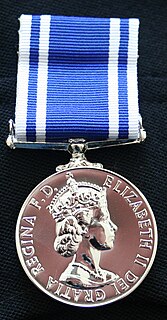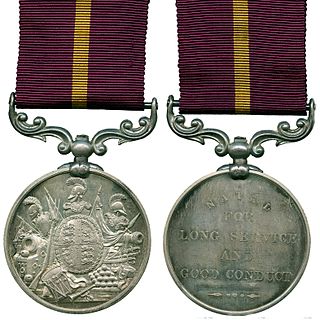
The Distinguished Conduct Medal, post-nominal letters DCM, was established in 1854 by Queen Victoria as a decoration for gallantry in the field by other ranks of the British Army. It is the oldest British award for gallantry and was a second level military decoration, ranking below the Victoria Cross, until its discontinuation in 1993 when it was replaced by the Conspicuous Gallantry Cross. The medal was also awarded to non-commissioned military personnel of other Commonwealth Dominions and Colonies.

The Meritorious Service Medal (MSM) is a British medal awarded to sergeants and warrant officers of the British armed forces for long and meritorious service. From 1916 to 1928, eligibility was extended to cover both valuable services by selected other ranks irrespective of length of service, and for gallantry not in the face of the enemy.

The Police Long Service and Good Conduct Medal is a decoration for police officers of the United Kingdom. First instituted in 1951, the medal is presented for twenty aggregate years of service in the police services of the United Kingdom.

The New Zealand Meritorious Service Medal is a meritorious and long service award for members of the New Zealand Defence Force. Initially established on 28 April 1898 as the Meritorious Service Medal, only members of the New Zealand Army were eligible for award. In 1985, a Royal Warrant established the current criteria for the medal making all members of the Army, Navy, and Air Force eligible for the award. Members of the defence forces above the rank of sergeant, who have at least 21 years of service, and hold their service's Long Service and Good Conduct Medal are eligible for the medal. The New Zealand Meritorious Service Medal is to be replaced by the New Zealand Defence Meritorious Service Medal, though holders of the superseded medal are still entitled to continue wearing it.
The Long Service and Good Conduct Medal is a military award recognizing 15 years of exemplary and unblemished service by non-commissioned and other ranks members of the New Zealand Defence Force. Established in 1985, these medals replaced the British Long Service and Good Conduct Medals with specific versions for New Zealand. There are three version of the Long Service and Good Conduct Medal, one each for the New Zealand Army, Royal New Zealand Navy, and the Royal New Zealand Air Force.

The Royal Naval Volunteer Reserve Long Service and Good Conduct Medal, initially designated the Royal Naval Volunteer Reserve Long Service Medal, was instituted in 1908. It could be awarded to part-time ratings in the United Kingdom's Royal Naval Volunteer Reserve after twelve years of service and good conduct. The medal was a Naval version of the Volunteer Long Service Medal and its successor, the Territorial Force Efficiency Medal.
The African Police Medal for Meritorious Service was a medal awarded to non-European police officers in British African colonies. Awarded from 1915-1938, the medal was replaced by the Colonial Police Medal and the Colonial Police Long Service Medal.

The Indian Meritorious Service Medal was a medal to recognize long and meritorious service by European non-commissioned officers in service of the East India Company's Army.

The Indian Meritorious Service Medal was a long and meritorious service medal awarded to Indian non-commissioned officers in the British Indian Army.

The Indian Long Service and Good Conduct Medal was a medal to recognize long and efficient service by Europeans in service of the East India Company's Army.
The New Zealand Defence Meritorious Service Medal is a military award of the New Zealand Defence Force (NZDF). Established by Royal Warrant 15 October 2013, the medal may be awarded to recognize meritorious exceptional performance, commitment, or innovation. Military and civilian personnel of the NZDF are eligible for this award regardless of rank or time in service. It will supersede the New Zealand Meritorious Service Medal.

The Volunteer Long Service Medal was instituted in 1894 as an award for long service by other ranks and some officers of the United Kingdom's Volunteer Force. Award of the medal was discontinued when it was superseded by the Territorial Force Efficiency Medal in 1908.

The Australian Meritorious Service Medal (1903–75) was awarded to warrant officers, non-commissioned officers and other ranks who had completed 22 years meritorious service with Australian Military Forces, and who had previously received the Army Long Service and Good Conduct Medal.

The Army Long Service and Good Conduct Medal was instituted by King William IV in 1830. The medal remained in use for 100 years, until it was replaced by the Medal for Long Service and Good Conduct (Military) in 1930. During that time the reverse of the medal remained virtually unchanged, while the design of the obverse was altered during the reigns of Queen Victoria, King Edward VII and King George V.

In May 1895, Queen Victoria authorised Colonial governments to adopt various British military medals and to award them to their local military forces. The Cape of Good Hope introduced this system in September 1895 and, in 1896, instituted the Army Long Service and Good Conduct Medal .

In May 1895, Queen Victoria authorised Colonial governments to adopt various British military medals and to award them to their local military forces. The Colony of Natal introduced this system in August 1895 and, in 1897, instituted the Army Long Service and Good Conduct Medal (Natal).

In May 1895, Queen Victoria authorised Colonial governments to adopt various British military medals and to award them to members of their local permanent military forces. The Cape of Good Hope introduced this system in September 1895 and, in 1896, instituted the Meritorious Service Medal .

In May 1895, Queen Victoria authorised Colonial governments to adopt various British military medals and to award them to members of their local permanent military forces. The Colony of Natal introduced this system in August 1895 and, in 1897, instituted the Meritorious Service Medal (Natal).

The Volunteer Long Service Medal was instituted in 1894 as an award for long service by other ranks and some officers of the United Kingdom's Volunteer Force. In 1896, the grant of the medal was extended to other ranks and officers who had served in the ranks of the Volunteer Forces throughout the British Empire. A separate new medal was instituted, the Volunteer Long Service Medal for India and the Colonies. Awarding of this medal was discontinued in stages when it was superseded in most territories by the Colonial Auxiliary Forces Long Service Medal in 1899 and in the remainder by the Efficiency Medal in 1930.

A number of new Sierra Leone medals were instituted in the decade from 1961, when the country gained independence.

















